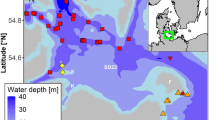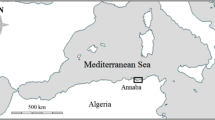Abstract
Otolith microstructure was used to distinguish specimens of Neosalanx taihuensis born in spring and autumn. Increment width during the early life stage was significantly narrower for spring-born than autumn-born juveniles, and the frequency distributions of the width of the first 5 increments were distinctive and diagnostic. Otolith growth trajectories and frequency distribution of the first 5 increments of spring-spawning adults displayed similar patterns to spring-born juveniles. Otolith growth trajectories of autumn-spawning adults were intermediate between those of spring- and autumn-born juveniles, and the frequency distribution of the width of the first 5 increments showed two modes, one similar to spring-born juveniles and the other similar to autumn-born juveniles. Populations of N. taihuensis have previously been shown to be dominated by spring-spawning fish. Thus, the putative life history of N. taihuensis can be summarized as: (1) a small part of the spring-born fish mature and spawn in autumn of the year of their birth, (2) the majority of the spring-born cohort matures and spawns in spring of the next year, and (3) offspring of the autumn-born fish mature and spawn in autumn of the following year. This stock-structure information should be considered in fisheries management for this species.






Similar content being viewed by others
References
Beacham TD, Candy JR, McIntosh B, Macconnachie C, Tabata A, Kaukinen K, Deng L, Miller KM, Withler RE, Varnavskaya N (2005) Estimation of stock composition and individual identification of sockeye salmon on a Pacific rim basis using microsatellite and major histocompatibility complex variation. Trans Am Fish Soc 134:1124–1146
Clausen LA, Bekkevold D, Hatifield EM, Mosegard H (2007) Application and validation of otolith microstructure as a stock identification method in mixed Atlantic herring (Clupea harengus) stocks in the North Sea and western Baltic. ICES J Mar Sci 64:377–385
Jónsdóttir IG, Marteinsdottir G, Campana SE (2007) Contribution of different spawning components to the mixed stock fishery for cod in Icelandic waters. ICES J Mar Sci 64:1749–1759
Brophy D, Danilowicz BS (2002) Tracing populations of Atlantic herring (Clupea harengus L.) in the Irish and Celtic Seas using otolith microstructure. ICES J Mar Sci 59:1305–1313
Dickey-Collas M, Damme CJ, Clausen LA, Fässler SM (2005) Within stock structure and TACs: an investigation into the spawning origin of North Sea herring using otolith microstructure and the dynamics of Downs herring. ICES CMK 12:1–14
Xie YH, Xie H (1997) Classification, distribution, and population ecology of Salangidae fishes. Chin J Fish 2:11–19 (in Chinese with English abstract)
Hu CL, Chen WX, Liu JS (1998) Status of transplantation and enhancement of icefishes in China and their development strategies. Reserv Fish 2:3–7 (in Chinese)
Ni Y, Zhu CD (2005) Fishes of the Taihu Lake. Shanghai Scientific and Technical Publishers, Shanghai, pp 217–221 (in Chinese)
Gong WB, Li HT, Xie SQ, Liu JS, Murphy BR, Xie SG (2009) Two spawning stocks of icefish Neosalanx taihuensis revealed from annual reproductive cycle analyses. Fish Sci 75:1157–1165
Hedger RD, Atkinson PM, Thibault I, Dodson JJ (2008) A quantitative approach for classifying fish otolith strontium: calcium sequences into environmental histories. Ecol Inf 3:207–217
Radhakrishnan KV, He WP, Liu M, Xie SG (2009) Otoliths—the biological CD-ROMs of fish. Curr Sci 8:1121–1122
Perter CS, Elise RI (2008) Validation of daily ring deposition in the otoliths of age-0 channel catfish. North Am J Fish Manag 28:212–218
Tonkin Z, King AJ, Robertson A (2008) Validation of daily increment formation and the effects of different temperatures and feeding regimes on short-term otolith growth in Australian smelt Retropinna semoni. Ecol Freshw Fish 17:312–317
Xie SG, Watanabe Y (2005) Hatch date-dependent differences in early growth and development recorded in the otolith microstructure of Trachurus japonicus. J Fish Biol 66:1720–1734
Piñeiro C, Rey J, Pontual H, García A (2008) Growth of Northwest Iberian juvenile hake estimated by combining sagittal and transversal otolith microstructure analyses. Fish Res 93:173–178
Fukuda N, Kuroki M, Shinoda A, Yanada Y, Okamnra A, Aoyama J, Tsukamoto K (2009) Influence of water temperature and feeding regime on otolith growth in Anguilla japonica glass eels and elvers: does otolith growth cease at low temperatures? J Fish Biol 74:1915–1933
Fu LJ, Xie YH, Li B, Zhao HC (1997) Study on daily-growth increment of otolith and the growth of larvae icefish. J Fish Sci China 4:21–27 (in Chinese with English abstract)
Yang QR, Liu JH, Wu Q, Wang K, Zhu BK (2007) Salmoniformes studies on daily-growth increment of otolith and growth of Taihu icefish, Neosalanx taihuensis. Freshw Fish 3:59–62 (in Chinese with English abstract)
Moksness E, Fossum P (1991) Distinguishing spring- and autumn-spawned herring larvae (Clupea harengus L.) by otolith microstructure. ICES J Mar Sci 48:61–66
Stenevik EK, Fossum P, Johannessen A, Folkvord A (1996) Identification of Norwegian spring spawning herring (Clupea harengus L.) larvae from spawning grounds off western Norway applying otolith microstructure analysis. Sarsia 80:285–292
Finn JE, Burger CV, Hollandbartels L (1997) Discrimination among populations of sockeye salmon fry with Fourier analysis of otolith banding patterns formed during incubation. Trans Am Fish Soc 126:559–578
Petursdottir G, Begg GA, Marteinsdottir G (2006) Discrimination between Icelandic cod (Gadus morhua L.) populations from adjacent spawning areas based on otolith growth and shape. Fish Res 80:182–189
Begg GA, Brown RW (2000) Stock identification of haddock (Melanogrammus aeglefinus) on Georges Bank based on otolith shape analysis. Trans Am Fish Soc 129:935–945
Begg GA, Overholtz WJ, Munroe NJ (2001) The use of internal otolith morphometrics for identification of haddock (Melanogrammus aeglefinus) stocks on Georges Bank. Fish Bull 99:1–14
Peterson BC, Bates TD (2008) Growth and feed efficiency of juvenile channel Catfish reared at different water temperatures and fed diets containing various levels of fish meal. North Am J Aquac 70:347–352
Cook AM, Duston J, Bradford RG (2010) Temperature and salinity effects on survival and growth of early life stage Shubenacadie River Striped Bass. Trans Am Fish Soc 139:749–757
Conover DO, Hurst TP (1998) Winter mortality of young-of-the-year Hudson River striped bass (Morone saxatilis): size-dependent patterns and effects on recruitment. Can J Fish Aquat Sci 55:1122–1130
Meekan MG, Vigliola L, Hansen A, Doherty PJ, Halford A, Carleton JH (2006) Bigger is better: size-selective mortality throughout the life history of a fast-growing clupeid, Spratelloides gracilis. Mar Ecol Prog Ser 317:237–244
Bobko SJ, Berkeley SA (2004) Maturity, ovarian cycle, fecundity, and age-specific parturition of black rockfish (Sebastes melanops). Fish Bull 102:418–429
Tracey SR, Lyle JM, Haddon M (2007) Reproductive biology and per-recruit analyses of striped trumpeter (Latris lineata) from Tasmania, Australia: implication for management. Fish Res 84:358–367
Acknowledgments
This research was financially supported by the National Basic Research Program of China (973 Program, No. 2009CB119200), the National Natural Science Foundation of China (No. 30771642 and 30972257), the Chinese Academy of Sciences Visiting Professorship for Senior International Scientists issued to B.R.M. (No. 2010T2S25), and the One Hundred Talents Programme of the Chinese Academy of Sciences issued to Dr. S. Xie and Networks of Aquaculture Centres in Asia and Pacific (No. ICE/SL/FIS/2007/02, NACA). Participation of B.R.M. was also supported by the Acorn Alcinda Foundation, Lewes, DE, USA.
Author information
Authors and Affiliations
Corresponding author
Rights and permissions
About this article
Cite this article
Wu, L., Liu, J.S., Wang, X.L. et al. Identification of individuals born in different spawning seasons using otolith microstructure to reveal life history of Neosalanx taihuensis . Fish Sci 77, 321–327 (2011). https://doi.org/10.1007/s12562-011-0333-z
Received:
Accepted:
Published:
Issue Date:
DOI: https://doi.org/10.1007/s12562-011-0333-z




